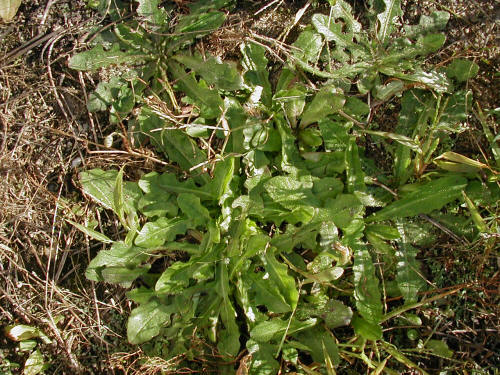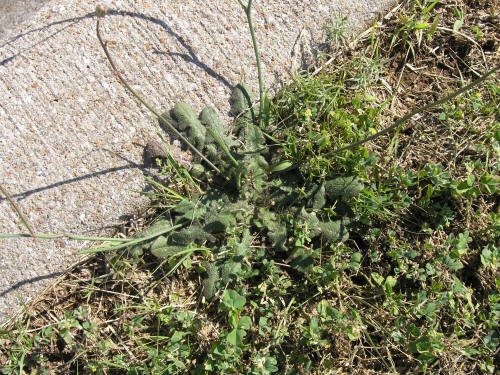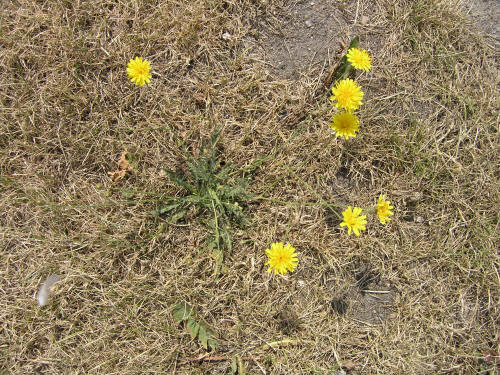Common Catsear
Common Catsear, Hairy Catsear
Hypochaeris radicata L.
Asteraceae (Sunflower Family)

▲ ▼ rosette of fuzzy, lobed leaves
▲ ▼ rosette of fuzzy, lobed leaves

▲ ▼ flowering plants with branched stems bearing inflorescences

▲ ▼ flowering plants with branched stems bearing inflorescences
▲ ▼ flowering plants with branched stems bearing inflorescences
▲ ▼ closer view of inflorescences
▲ ▼ closer view of inflorescences
Hypochoeris radicata L., Common Catsear, Rough Catsear: (Bayer Code: HRYRA; US Code HYRA3)
- European native summer annual that first forms a rosette of leaves, followed by an upright, branched, usually leafless flowering stem that grows 6-24 inches tall; stems green, round and mostly hairless (could be hairy on lower portions of the stem
- Leaves are almost all at the base in a rosette, alternate, lanceolate, with lobed margins (with rounded lobes); leaves usually covered with stiff hairs on both sides
- Head inflorescences are 0.75-1.5 inches in diameter, usually single at tips of openly-branched stems; no disk florets and 20-30 yellow ray florets
- Bracts below inflorescence form a cylindrical to urn shape below the head, are lanceolate, of unequal length, with darker pointed tips and hairs along the midribs
- Flowering is throughout its growing season
- After flowering the florets from the head become a loose globe-shape of white hairs from the pappus (parachute-like hairs) attached to small, brown mature seed/fruit
- Found in lawns, pastures, open woods, non-crop areas, right-of-ways; prefers more fertile soils than other species in this group
- Is toxic to horses if grazed
- Similar species:
- Smooth Catsear (Hypochaeris radicata) has similar yellow flowers, but has basal leaves that are hairless, and have smooth margins or toothed margins
- Yellow Hawkweed (Hieracium caespitosum) has hairy flowering stems and basal leaves, with dark black hairs on bracts below inflorescence, plus the flowers are tightly clustered at the tip of an otherwise unbranched flowering stem
- Smooth Hawksbeard (Crepis capillaris) has similar, but smaller, yellow flowers, but they are in larger, more open clusters; plus stems and basal leaves are hairless, and basal leaves have deep, pointed lobes, and there are smaller leaves along the flowering stems
- Dandelion (Taraxacum officinale) has similar flowers, but has dark green to reddish-green, nearly hairless, deeply toothed rosette leaves, and flowering stems are single, pale green to pinkish, hollow and leafless
(Updated November 28, 2022)